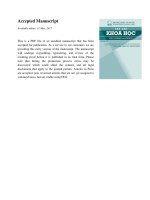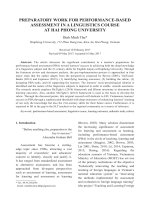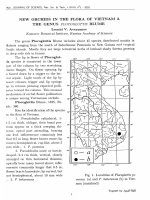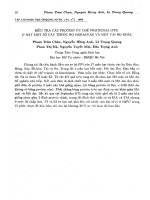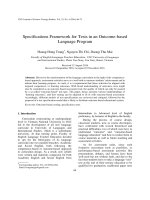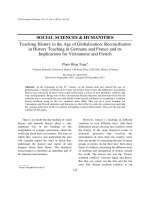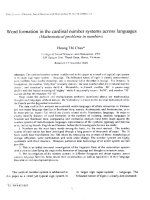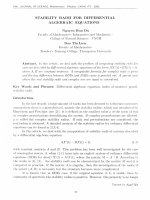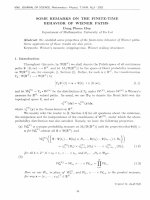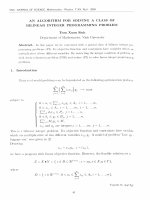DSpace at VNU: Generalized convolutions for the integral transforms of fourier type and applications
Bạn đang xem bản rút gọn của tài liệu. Xem và tải ngay bản đầy đủ của tài liệu tại đây (228.2 KB, 16 trang )
GENERALIZED CONVOLUTIONS FOR THE INTEGRAL
TRANSFORMS OF FOURIER TYPE AND APPLICATIONS
Bui Thi Giang
∗
and Nguyen Minh Tuan
1
∗∗
Abstract
In this paper we provide several new generalized convolutions for the
Fourier-cosine and the Fourier-sine transforms and consider some applications. Namely, the linear space L1 (Rd ), equipped with each of the convolution multiplications constructed, becomes a normed ring, and the explicit
solution in L1 (Rd ) of the integral equation with the mixed Toeplitz-Hankel
kernel is obtained.
Mathematics Subject Classification: 42A85, 44A35, 44A30, 45E10
Key Words and Phrases: Hartley transform, generalized convolution,
normed ring, integral equation of convolution type
1. Introduction
The Fourier convolution of two functions g and f is defined by the
integral
1
(f ∗ g)(x) =
g(y)f (x − y)dy.
d
F
(2π) 2 Rd
The theory of the convolutions of integral transforms has been developed
for a long time and is applied in many fields of mathematics. Historically,
Churchill introduced the generalized convolutions of the integral transforms
and found their application for solving boundary value problems in 1940
1
This work is partially supported by grant QGTD-08-09, Vietnam National University.
2
B.T. Giang, N.M. Tuan
(see [8, 9]). In 1958, Vilenkin gave a convolution for the integral transform
in a specific space of integrable functions (see [29]). Kakichev presented
some methods to build generalized convolutions of integral transforms in
1967; he formulated the concept of the generalized convolutions of integral
transforms and dealt with convolutions for power series in 1990 (see [14, 15]).
Also, in his article [14] he pointed out that generalized convolutions of many
known transforms had not been found yet.
In the recent years, many convolutions, generalized convolutions, and
poly-convolutions of well-known integral transforms as the Fourier, Hankel,
Mellin, Laplace transforms, and their applications have been investigated
(see for example, [4, 5, 6, 7, 10, 16, 17, 24, 26, 27, 30]). However, there
have not been so many generalized convolutions of the integral transforms
of Fourier type, which from our point of view, deserve interest.
Recall the definitions of the Fourier-cosine and Fourier-sine transforms:
(Tc f )(x) :=
1
(2π)
d
2
cos(xy)f (y)dy; (Ts f )(x) :=
Rd
1
d
(2π) 2
sin(xy)f (y)dy,
Rd
where cos(xy) := cos(<x, y>), sin(xy) := sin(<x, y>).
The main purpose of this paper is to construct some generalized convolutions for the transformations Tc , Ts , and to solve, by their means, integral
equations with mixed Toeplitz-Hankel kernel.
The paper consists of three sections and is organized as follows. In
Section 2, we find eight new generalized convolutions with weight-function
being the function cos xh, or sin xh for Tc , Ts . We call h the shift in the convolution transform. From the factorization identities of those convolutions,
we emphasize on the fact (perhaps interesting): the shift in the left-side
moves only into the weight-function in the right-side. This lays in the basis
of our solution of convolutional integral equations with different shifts, as
equation (3.5).
There are two subsections in Section 3. In Subsection 3.1, we deal
with some normed ring structures of the linear space L1 (Rd ). Namely,
the space L1 (Rd ), equipped with each of the convolution multiplications
obtained in Section 2, becomes a normed ring. In Subsection 3.2, we provide
a sufficient and necessary condition for the solvability of an integral equation
with the mixed Toeplitz-Hankel kernel having shifts, and obtain its explicit
solution via the Hartley transform by using the constructed convolutions.
Finally, the advantage of the convolutional approach to the equations as in
Subsection 3.2 over that relating to the Fourier transform is discussed.
GENERALIZED CONVOLUTIONS FOR THE INTEGRAL . . .
3
2. Generalized convolutions
The nice idea of a generalized convolution focuses on the factorization
identity. We now remind the concept of convolutions.
Let U1 , U2 , U3 be linear spaces on the field of scalars K, and let V be a
commutative algebra on K. Suppose that K1 ∈ L(U1 , V ), K2 ∈ L(U2 , V ),
K3 ∈ L(U3 , V ) are linear operators from U1 , U2 , U3 to V, respectively. Let δ
denote an element in the algebra V.
Definition 2.1. (see [6, 14, 17]) A bilinear map ∗ : U1 × U2 :−→ U3 is
called a convolution with weight-element δ for K3 , K1 , K2 (in that order), if
the following identity holds: K3 (∗(f, g)) = δK1 (f )K2 (g), for any f ∈ U1 , g ∈
U2 . This identity is called the factorization identity of the convolution.
The image ∗(f, g) is denoted by f
δ
∗
K3 ,K1 ,K2
g. If δ is the unit of V, we
say briefly the convolution for K3 , K1 , K2 . In the case of U1 = U2 = U3 and
δ
K1 = K2 = K3 , the convolution is denoted simply by f ∗ g, and by f ∗ g if
K1
K1
δ is the unit of V . Observe that the factorization identities play a key role
in many applications.
In what follows, we consider U1 = U2 = U3 = L1 (Rd ) with the Lebesgue
measure, and let V be the algebra of all measurable functions (real or complex) on Rd .
For any given h ∈ Rd , put α(x) = cos xh, β(x) = sin xh. In this
section we provide eight new generalized convolutions for Tc , Ts with weightfunction α(x), or β(x).
Theorem 2.1. If f, g ∈ L1 (Rd ), then each of the integral operations
(2.1), (2.2), (2.3), (2.4) below defines a generalized convolution as:
α
1
f (x − u + h) + f (x − u − h)
d
4(2π) 2 Rd
+ f (x + u + h) + f (x + u − h) g(u)du,
1
α
(f
∗ g)(x) :=
− f (x − u + h) − f (x − u − h)
d
Tc ,Ts ,Ts
4(2π) 2 Rd
+ f (x + u + h) + f (x + u − h) g(u)du,
β
1
f (x − u + h) − f (x − u − h)
(f
∗ g)(x) :=
d
Tc ,Ts ,Tc
4(2π) 2 Rd
+ f (x + u + h) − f (x + u − h) g(u)du
(f ∗ g)(x) :=
Tc
(2.1)
(2.2)
(2.3)
4
B.T. Giang, N.M. Tuan
(f
β
∗
Tc ,Tc ,Ts
g)(x) :=
1
f (x − u + h) − f (x − u − h)
d
4(2π) 2 Rd
− f (x + u + h) + f (x + u − h) g(u)du.
(2.4)
P r o o f. Let us first prove the convolution (2.1). We have
1
α
(2π)
|f ∗ g|(x)dx ≤
d
2
Tc
Rd
1
4(2π)d
1
+
4(2π)d
1
+
4(2π)d
+
=
|f (x − u + h)||g(u)|dxdu
Rd
Rd
|f (x − u − h)||g(u)|dxdu
Rd
Rd
Rd
Rd
Rd
Rd
|f (x + u + h)||g(u)|dxdu
|f (x + u − h)||g(u)|dxdu
1
(2π)
1
4(2π)d
|f (x)|dx
d
2
Rd
1
d
(2π) 2
|g(u)|du
< +∞.
Rd
Therefore, the integral expression (2.1) is a bilinear map from L1 (Rd ) ×
L1 (Rd ) into L1 (Rd ). We now prove the factorization identity. We have
α(x)(Tc f )(x)(Tc g)(x) =
=
1
4(2π)d
cos xh
(2π)d
cos xu cos xvf (u)g(v)dudv
Rd
Rd
cos x(u + v + h) + cos x(u − v + h) + cos x(u + v − h)
Rd
Rd
+ cos x(u − v − h) f (u)g(v)dudv =
1
4(2π)d
cos xt f (t − y − h)
Rd
Rd
+ f (t + y + h) + f (t − y + h) + f (t + y − h) g(y)dydt
=
1
(2π)
d
2
Rd
α
α
Tc
Tc
cos xt(f ∗ g)(t)dt = Tc (f ∗ g)(x),
as desired. Thus, the convolution (2.1) is proved.
By using the following identities
GENERALIZED CONVOLUTIONS FOR THE INTEGRAL . . .
cos xh sin xu sin xv =
5
1
− cos x(u + v + h) + cos x(u − v + h)
4
− cos x(u + v − h) + cos x(u − v − h) ,
sin xh sin xu cos xv =
1
− cos x(u + v + h) − cos x(u − v + h)
4
+ cos x(u + v − h) + cos x(u − v − h) ,
sin xh cos xu sin xv =
1
− cos x(u + v + h) + cos x(u − v + h)
4
+ cos x(u + v − h) − cos x(u − v − h) ,
we can prove the convolutions (2.2), (2.3), (2.4). The theorem is proved.
The following identities hold also:
cos xh cos xu sin xv =
1
sin x(u + v + h) + sin x(u + v − h)
4
− sin x(u − v + h) − sin x(u − v − h) ,
cos xh sin xu cos xv =
1
sin x(u + v + h) + sin x(u + v − h)
4
+ sin x(u − v + h) + sin x(u − v − h) ,
sin xh sin xu sin xv =
1
sin x(u − v + h) − sin x(u − v − h)
4
− sin x(u + v + h) + sin x(u + v − h) ,
sin xh cos xu cos xv =
1
sin x(u + v + h) − sin x(u + v − h)
4
+ sin x(u − v + h) − sin x(u − v − h) .
Then, similarly to the proof of Theorem 2.1, we can prove the following
theorem.
Theorem 2.2. If f, g ∈ L1 (Rd ), then each of the integral transforms
(2.5), (2.6), (2.7), (2.8) below defines a generalized convolution as:
1
α
(f
∗ g)(x) :=
f (x − u + h) + f (x − u − h)
d
Ts ,Tc ,Ts
4(2π) 2 Rd
− f (x + u + h) − f (x + u − h) g(u)du,
(2.5)
6
B.T. Giang, N.M. Tuan
(f
α
∗
g)(x) :=
1
f (x − u + h) + f (x − u − h)
d
4(2π) 2 Rd
+ f (x + u + h) + f (x + u − h) g(u)du,
β
1
f (x − u + h) − f (x − u − h)
(f ∗ g)(x) :=
d
Ts
4(2π) 2 Rd
− f (x + u + h) + f (x + u − h) g(u)du,
β
1
(f
∗ g)(x) :=
− f (x − u + h) + f (x − u − h)
d
Ts ,Tc ,Tc
4(2π) 2 Rd
− f (x + u + h) + f (x + u − h) g(u)du.
Ts ,Ts ,Tc
(2.6)
(2.7)
(2.8)
Example 2.1. Consider d = 1. Put u(x) := 1/πx. The Hilbert transform of a function (or signal) v(x) is given by
+∞
(Hv)(x) = p.v.
u(x − y)v(y)dy,
−∞
provided this integral exists as Cauchy’s principal value. This is precisely
the Fourier convolution of v with the tempered distribution p.v. u(x).
x
Put r(x) := √
, and gˇ(x) := g(−x). By (2.1), we have
2 2π(x2 − h2 )
α
(u ∗ g)(x) = p.v.(r ∗ g)(x) + p.v.(r ∗ gˇ)(x).
Tc
F
F
This means that the convolution (2.1) can be considered as a sum of the
Fourier convolutions of r with the tempered distributions p.v. g(x) and
p.v. gˇ(x). Similarly,
β
h
(u ∗ g)(x) = p.v.(s ∗ gˇ)(x) − p.v.(s ∗ g)(x), where s(x) := √
.
Ts
F
F
2 2π(x2 − h2 )
3. Application
3.1
Normed ring structures on L1 (Rd )
This subsection deals with the construction of the normed ring structures
on the space L1 (Rd ) that could be used in the theories of Banach algebra
(see [21]).
Definition 3.1. (see [19]) A vector space V with a ring structure and
a vector norm is called a normed ring if vw ≤ v w , for all v, w ∈ V.
If V has a multiplicative unit element e, it is also required that e = 1.
GENERALIZED CONVOLUTIONS FOR THE INTEGRAL . . .
7
Let X denote the linear space L1 (Rd ). For each of the convolutions in
Section 2, the norm of f ∈ X is chosen as
f =
1
|f (x)|dx.
d
(2π) 2
Rd
Theorem 3.1. The space X, equipped with each of the convolution
multiplications, becomes a normed ring having no unit.
P r o o f. The proof is divided into two steps.
Step 1. X has a normed ring structure. It is clear that X, equipped
with each of the convolution multiplications in Theorems 2.1 and 2.2, has
the ring structure. We have to prove the multiplicative inequality. We now
prove this assertion concerning the convolution (2.1), the proof being the
same in the other cases.
Obviously,
|f (x ± u ± h)|dx =
Rd
We then have
1
(2π)
d
2
Rd
1
4(2π)d
1
+
4(2π)d
1
+
4(2π)d
α
|f ∗ g|(x)dx ≤
Tc
+
=
(2π)
1
4(2π)d
|f (x − u + h)||g(u)|dxdu
Rd
Rd
|f (x − u − h)||g(u)|dxdu
Rd
Rd
Rd
Rd
Rd
Rd
|f (x + u + h)||g(u)|dxdu
|f (x + u − h)||g(u)|dxdu
1
d
2
|f (x)|dx.
Rd
|f (x)|dx
Rd
1
d
(2π) 2
|g(u)|du
= f
g .
Rd
α
Hence, f ∗ g ≤ f . g .
Tc
Step 2. X has no unit. For briefness of our proof, we use the common symbols: ∗ for the convolutions, and γ0 for the weight functions α, β.
Suppose that there exists an e ∈ X such that f = f ∗ e = e ∗ f for every
1
2
f ∈ X. Choose δ(x) := e− 2 |x| ∈ L1 (Rd ). Obviously, (Ts δ)(x) ≡ 0. We then
have (F δ)(x) = (Fˇ δ)(x) = (Tc δ)(x) = δ(x) (see [21, Theorem 7.6]). By
δ = δ ∗ e = e ∗ δ and the factorization identities of the convolutions, we have
Tj (δ) = γ0 (Tk δ)(T e),
(3.1)
8
B.T. Giang, N.M. Tuan
where Tj , Tk , T ∈ {Tc , Ts } (note that it may be Tj = Tk = T = Tc , etc.).
Proof for convolution (2.1). By (3.1), we have δ = γ0 δ(Tc e). As δ(x) = 0
for every x ∈ Rd , γ0 (x)(Tc e)(x) = 1 for every x ∈ Rd . Since |γ0 (x)| ≤ 1, the
last identity contradicts to the Riemann-Lebesgue lemma as: lim (Tc e)(x) =
x→∞
0 (see [21, Theorem 7.5]).
Proof for the convolutions (2.2), (2.3), (2.4). Using (3.1) and (Ts δ)(x) ≡
0, we have (Tc δ)(x) ≡ 0. But, this fails.
Proof for the convolutions (2.5), (2.6), (2.8). Consider δ0 (x) = −2 ∂δ(x)
∂x1
1
2
= 2x1 e− 2 |x| . Obviously, δ0 (x) ∈ L1 (Rd ). Integrating by parts on variable
y1 we get
(Tc δ0 )(x) =
(Ts δ0 (x) =
−2
(2π)
−2
d
2
d
2
cos xy
Rd
sin xy
∂δ(y)
∂y1
dy =
∂δ(y)
∂y1
dy =
(2π) Rd
= 2x1 (Tc δ)(x) = 2x1 δ(x).
−2x1
d
2
(2π)
2x1
(2π)
1
Rd
1
d
2
2
sin(xy)e− 2 |y| dy = 0,
2
cos(xy)e− 2 |y| dy
Rd
We now insert δ0 (x) into (3.1) and note that Tj = Ts , Tk = Tc we obtain
x1 δ(x) ≡ 0, which fails.
Proof for convolution (2.7). Inserting δ0 (x) into (3.1), we get 2x1 δ(x)
= γ0 (x)2x1 δ(x)(Ts e)(x). This implies γ0 (x)(Ts e)(x) = 1 for every x1 = 0
which fails because
lim
γ0 (x)(Ts e)(x) = 0.
x1 ,...xd →∞
Hence, X has no unit. The theorem is proved.
3.2
Integral equations of convolution type
The main aim of this section is to apply the convolutions in Section 2 for
solving some integral equations of convolution type.
3.2.1
The Hartley transform
The multi-dimensional Hartley transform is defined as
1
(Hf )(x) =
cas(xy)f (y)dy,
d
(2π) 2 Rd
where f (x) is a function (real or complex) defined on Rd , and the integral
kernel, known as the cosine-and-sine or cas function, is defined as cas xy =
cos xy + sin xy (see [12]). The Hartley transform is a spectral transform
closely related to the Fourier transform (see [1, 12]). The inversion theorem
GENERALIZED CONVOLUTIONS FOR THE INTEGRAL . . .
9
and some basic properties of the one-dimensional Hartley transform are
well-known (see [1, 2, 3, 12, 18]). In this subsection we give a brief proof
of the inversion theorem for the multi-dimensional Hartley transform and
in Subsubsection 3.2.2 we show that it is useful for solving some integral
equations.
Let S denote the set of all infinitely differentiable functions on Rd such
that
sup sup (1 + |x|2 )N |(Dα f )(x)| < ∞
x
|α|≤N x∈Rd
for N = 0, 1, 2, . . . (see [21]). As F and F −1 are continuous linear maps of
S into S, H is also continuous (see [21, Theorem 7.7]).
Theorem 3.2. (inversion theorem, see [12]) If f ∈ L1 (Rd ), and if Hf ∈
then
1
(Hf )(y) cas(xy)dy = f (x)
f0 (x) :=
d
(2π) 2 Rd
L1 (Rd ),
for almost every x ∈ Rd .
P r o o f. Let us first prove that if g ∈ S, then
1
g(x) =
(Hg)(y) cas(xy)dy.
d
(2π) 2 Rd
Indeed, for any λ > 0, put
B(0, λ) := {y = (y1 , . . . , yd ) ∈ Rd : |yk | ≤ λ, ∀k = 1, . . . , d}
(3.2)
the d-dimensional box in Rd . By induction on d, we can prove
[cos y(x − t) + sin y(x + t)]dy =
B(0,λ)
2d sin λ(x1 − t1 ) . . . sin λ(xd − td )
.
(x1 − t1 ) . . . (xd − td )
Since g ∈ S, Theorem 12 in [28] can be applied for this function. As the
inner integral function (Hg)(y) cas xy on the right-side of (3.2) belongs to S,
the integral on the right side of (3.2) converges uniformly on Rd according
to each of variables x1 , . . . , xd . Therefore, we can use the Fubini’s theorem,
Theorem 12 in [28], and the above identity to calculate the integrals as
follows
1
1
(Hg)(y) cas(xy)dy = lim
cas(xy)(Hg)(y)dy
d
d
λ→∞
d
(2π) 2 R
(2π) 2 B(0,λ)
1
= lim
cas(xy)
cas(yt)g(t)dtdy
λ→∞ (2π)d Rd
B(0,λ)
1
λ→∞ (2π)d
= lim
g(t)
Rd
[cos y(x − t) + sin y(x + t)]dy dt
B(0,λ)
10
B.T. Giang, N.M. Tuan
=
1
lim
(2π)d λ→∞
g(t)
Rd
2d sin λ(x1 − t1 ) . . . sin λ(xd − td )
dt = g(x).
(x1 − t1 ) . . . (xd − td )
Thus, identity (3.2) is proved.
Let g ∈ S be given. Using Fubini’s theorem, we get
f (x)(Hg)(x)dx =
Rd
g(y)(Hf )(y)dy.
(3.3)
Rd
Inserting the inversion formula (3.2) into the right-side of (3.3) and using
Fubini’s theorem, we obtain
1
f (x)(Hg)(x)dx =
(Hg)(x) cas(xy)dx (Hf )(y)dy
d
Rd
Rd
(2π) 2 Rd
=
(Hg)(x)
Rd
1
d
(2π) 2
(Hf )(y) cas(xy)dy dx =
Rd
Rd
f0 (x)(Hg)(x)dx.
By using (3.2), we can prove that transform H is a continuous, linear, oneto-one map of S onto S, of period 2, whose inverse is continuous. Therefore,
the functions Hg cover all of S. We then have
Rd
(f0 (x) − f (x))Φ(x)dx = 0
(3.4)
for every Φ ∈ S. Taking into account that S is dense in L1 (Rd ), we conclude
that f0 (x) − f (x) = 0 for almost every x ∈ Rd . The theorem is proved.
Corollary 3.1. (uniqueness theorem) If f ∈ L1 (Rd ), and if Hf = 0
in L1 (Rd ), then f = 0 in L1 (Rd ).
3.2.2
Integral equations with the mixed Toeplitz-Hankel kernel
Let h1 , h2 ∈ Rd be given. Consider the integral equation of the form
λϕ(x) +
1
d
(2π) 2
Rd
[k1 (x + y − h1 ) + k2 (x − y − h2 )]ϕ(y)dy = p(x), (3.5)
where λ ∈ C is predetermined, k1 , k2 , p are given, and ϕ(x) is to be determined.
In what follows, given functions are assumed in L1 (Rd ), and unknown
function will be determined there. Therefore, the functional identity f (x) =
g(x) means that it is valid for almost every x ∈ Rd . However, if both functions f, g are continuous, there should be emphasis that this identity must
be true for every x ∈ Rd .
GENERALIZED CONVOLUTIONS FOR THE INTEGRAL . . .
11
Put γ1 (x) := cos xh1 ; γ2 (x) := sin xh1 ; γ3 (x) := cos xh2 ; γ4 (x) :=
sin xh2 , and write:
A(x) := λ + γ1 (x)(Tc k1 )(x) − γ2 (x)(Ts k1 )(x) + γ3 (x)(Tc k2 )(x)
− γ4 (x)(Ts k2 )(x); B(x) := γ1 (x)(Ts k1 )(x) + γ2 (x)(Tc k1 )(x)
− γ3 (x)(Ts k2 )(x) − γ4 (x)(Tc k2 )(x); C(x) := γ1 (x)(Ts k1 )(x)+
γ2 (x)(Tc k1 )(x) + γ3 (x)(Ts k2 )(x) + γ4 (x)(Tc k2 )(x); D(x) := λ−
γ1 (x)(Tc k1 )(x) + γ2 (x)(Ts k1 )(x) + γ3 (x)(Tc k2 )(x) − γ4 (x)(Ts k2 )(x);
DTc (x) := (Tc p)(x)D(x) − (Ts p)(x)B(x); DTs (x) := (Ts p)(x)A(x)
− (Tc p)(x)C(x); DTc ,Ts (x) := A(x)D(x) − C(x)B(x).
(3.6)
Theorem 3.3. Assume that DTc ,Ts (x) = 0 for every x ∈ Rd , and
DTs
1
d
DTc ,Ts ∈ L (R ). Then equation
DTc +DTs
H D
∈ L1 (Rd ). In this
Tc ,Ts
DTc +DTs
by ϕ(x) = H D
(x).
Tc ,Ts
DTc
DTc ,Ts ,
(3.5) has solution in L1 (Rd ) if and only if
case the solution of the equation is given
P r o o f. Let us first prove the following lemma.
Lemma 3.1. Let f1 , f2 ∈ L1 (Rd ). Assume that f1 (x) = f1 (−x), and
f2 (x) = −f2 (−x), for every x ∈ Rd . Then H(f1 + f2 )(x) = H(f1 − f2 )(−x).
P r o o f. Obviously, f1 + f2 , f1 − f2 ∈ L1 (Rd ); Tc f2 = Ts f1 = 0;
(Tc f1 )(x) = (Tc f1 )(−x); and (Ts f2 )(−x) = −(Ts f2 )(x). We then have
H(f1 + f2 )(x) = (Tc + Ts )(f1 + f2 )(x) = (Tc f1 )(x) + (Ts f2 )(x), and H(f1 −
f2 )(−x) = (Tc + Ts )(f1 − f2 )(−x) = (Tc f1 )(−x) − (Ts f2 )(−x) = (Tc f1 )(x) +
(Ts f2 )(x). The lemma is proved.
We now prove Theorem 3.3. Note that the shift h in the convolutions in
Theorems 2.1, 2.2 is separate. From convolutions in Theorem 2.1 it follows
that
1
(2π)
d
2
Rd
γ1
γ1
Tc
Tc ,Ts ,Ts
f (x + y − h1 )g(y)dy = (f ∗ g)(x) + (f
− (f
1
(2π)
d
2
Rd
γ2
∗
Tc ,Ts ,Tc
∗
g)(x) + (f
γ3
γ3
Tc
Tc ,Ts ,Ts
f (x − y − h2 )g(y)dy = (f ∗ g)(x) − (f
− (f
γ4
∗
Tc ,Ts ,Tc
g)(x)
∗
γ2
∗
Tc ,Tc ,Ts
g)(x),
g)(x)
g)(x) − (f
γ4
∗
Tc ,Tc ,Ts
g)(x).
12
B.T. Giang, N.M. Tuan
By the factorization identities of these convolutions, we have
Tc
1
d
(2π) 2
Rd
f (x + y − h1 )g(y)dy
= γ1 (x) (Tc f )(x)(Tc g)(x)
+ (Ts f )(x)(Ts g)(x) − γ2 (x) (Ts f )(x)(Tc g)(x) − (Tc f )(x)(Ts g)(x) , (3.7)
Tc
1
d
(2π) 2
Rd
f (x − y − h2 )g(y)dy
= γ3 (x) (Tc f )(x)(Tc g)(x)
− (Ts f )(x)(Ts g)(x) − γ4 (x) (Ts f )(x)(Tc g)(x) + (Tc f )(x)(Ts g)(x) . (3.8)
Similarly, by using the convolutions in Theorem 2.2, we have
Ts
1
d
(2π) 2
Rd
f (x + y − h1 )g(y)dy
= −γ1 (x) (Tc f )(x)(Ts g)(x)
− (Ts f )(x)(Tc g)(x) + γ2 (x) (Ts f )(x)(Ts g)(x) + (Tc f )(x)(Tc g)(x) , (3.9)
Ts
1
d
(2π) 2
Rd
f (x − y − h2 )g(y)dy
= γ3 (x) (Tc f )(x)(Ts g)(x)
+ (Ts f )(x)(Tc g)(x) − γ4 (x) (Ts f )(x)(Ts g)(x) − (Tc f )(x)(Tc g)(x) .
(3.10)
Necessity. Suppose that equation (3.5) has a solution ϕ ∈ L1 (Rd ). Applying Tc and Ts to both sides of the equation and using (3.7), (3.8), (3.9),
(3.10), we obtain the system of two linear equations
A(x) (Tc ϕ)(x) + B(x) (Ts ϕ)(x) = (Tc p)(x)
C(x) (Tc ϕ)(x) + D(x) (Ts ϕ)(x) = (Ts p)(x),
(3.11)
where A(x), B(x), C(x), D(x) are defined as in (3.6), and (Tc ϕ)(x), (Ts ϕ)(x)
are the unknown functions. The determinants DTc ,Ts (x), DTc (x), DTs (x)
are determined as in (3.6). Since DTc ,Ts (x) = 0 for every x ∈ Rd , we
find (Tc ϕ)(x), (Ts ϕ)(x). Unfortunately, the transforms Tc , Ts have no inverse transforms. We shall use the inverse formula of the Hartley transform to obtain the function ϕ(x). By DTc ,Ts (x) = 0 for every x ∈ Rd ,
D (x)
D (x)
we get (Tc ϕ)(x) = DT T,Tc (x) , (Ts ϕ)(x) = DT T,Ts (x) . Hence, (Hϕ)(x) =
c
s
DTc (x)+DTs (x)
. We now can
DTc ,Ts (x)
DTc (x)+DTs
H
(x). Thus,
DTc ,Ts
c
s
use the inverse Hartley transform to get ϕ(x) =
H
DTc +DTs
DTc ,Ts
∈ L1 (Rd ).
GENERALIZED CONVOLUTIONS FOR THE INTEGRAL . . .
Sufficiency. Consider ϕ(x) = H
f1 (x) :=
DTc (x)
DTc ,Ts (x) ,
f2 (x)
DTc +DTs
DTc ,Ts
13
(x). By (3.6), the functions
D (x)
:= DT T,Ts (x) satisfy the conditions of Lemma 3.1.
c s
DTc +DTs
DTc −DTs
(x) = H D
(−x). Applying the
DTc ,Ts
Tc ,Ts
We then have ϕ(x) = H
inverse Hartley transform, we get
DTc (x) + DTs (x)
(Hϕ)(x) =
,
DTc ,Ts (x)
(Hϕ)(−x) =
DTc (x) − DTs (x)
.
DTc ,Ts (x)
As (Hϕ)(x) = (Tc + Ts )ϕ)(x), and (Hϕ)(−x) = (Tc − Ts )ϕ)(x), we find
D (x)
D (x)
(Tc ϕ)(x) = DT T,Tc (x) , (Ts ϕ)(x) = DT T,Ts (x) . Hence, (Tc ϕ)(x) and (Ts ϕ)(x)
c s
c s
fulfill (3.11). We thus have
A(x) + C(x) (Tc ϕ)(x) + B(x) + D(x) (Ts ϕ)(x) = (Hp)(x).
Equivalently,
H λϕ(x) +
1
d
(2π) 2
Rd
[k1 (x + y − h1 ) + k2 (x − y − h2 )]ϕ(y)dy = (Hp)(x).
By using the uniqueness theorem of the Hartley transform, ϕ fulfills equation
(3.5) for almost every x ∈ Rd (see [12]). The theorem is proved.
In the general theory of integral equations, the assumption that DTc ,Ts (x)
= 0 for every x ∈ Rd as in Theorem 3.3 is considered the normally solvable
condition of the integral equation.
It is known that (3.5) is the Fredholm integral equation of first kind if
λ = 0, and that of second kind if λ = 0. For the second kind, Proposition
3.1 below is the illustration of the conditions appearing in Theorem 3.3.
Proposition 3.1. Assume that λ = 0. Then
(a) DTc ,Ts (x) = 0 for every x outside a ball with finite radius.
(b) If DTc ,Ts (x) = 0 for every x ∈ Rd , and if Tc p, Ts p ∈ L1 (Rd ), then
DTs
DTc
1
d
DT ,T , DT ,T ∈ L (R ).
c
s
c
s
P r o o f. (a) By the Riemann-Lebesgue lemma for the transforms Tc , Ts ,
the function DTc ,Ts (x) is continuous on Rd , and lim DTc ,Ts (x) = λ2 . Now
|x|→∞
item (a) follows from λ = 0 and the continuity of DTc ,Ts (x).
(b) By the continuity of DTc ,Ts (x) and lim DTc ,Ts (x) = λ2 = 0, there
|x|→∞
exist R > 0, ε1 > 0 so that inf |DTc ,Ts (x)| > ε1 . Since DTc ,Ts (x) is contin|x|>R
uous, not vanished in the compact set: S(0, R) = {x ∈ Rd : |x| ≤ R}, there
14
B.T. Giang, N.M. Tuan
exists ε2 > 0 so that inf |DTc ,Ts (x)| > ε2 . We then have sup
|x|≤R
max{ ε11 , ε12 } < ∞. This implies that the function
x∈Rd
1
|DTc ,Ts (x)|
≤
1
|DTc ,Ts (x)| is continuous and
∈ L1 (Rd ), then DTc , DTs ∈
bounded on Rd . We now prove that if Tc p, Ts p
L1 (Rd ). Indeed, it is easily seen that the functions A(x), B(x), C(x), D(x)
are continuous and bounded on Rd . This implies that DTc , DTs ∈ L1 (Rd ).
D
D
Thus, |DT ,TTc (x)| , |DT ,TTs (x)| ∈ L1 (Rd ). The proposition is proved.
c
s
c
s
Example 3.1. By calculating the right side of (3.6), we get
DTc ,Ts (x) = λ2 + 2λ[γ3 (x)(Tc k2 )(x) − γ4 (x)(Ts k2 )(x)]
+ (Tc k2 )2 (x) + (Ts k2 )2 (x) − (Tc k1 )2 (x) − (Ts k1 )2 (x).
|x|2
If k1 (x) = k2 (x) = e− 2 , then DTc ,Ts (x) = λ λ + 2γ3 (x)e−
DTc ,Ts (x) = 0 for every x ∈ Rd , provided λ ∈ C \ [−2, 2].
|x|2
2
. Therefore,
Comparison 3.1. (a) In constructing some generalized convolutions,
the papers [17, 22, 23, 24, 25, 26, 27] solved their integral equations. Those
papers provided the sufficient conditions for the solvability of the equations
and obtained the implicit solutions of those equations via the Wiener-L`evy
theorem. By means of the normally solvable condition of an integral equation, the generalized convolutions in Section 2 work out the sufficient and
necessary condition for the solvability of the equation (3.5) and its explicit
solution via the Hartley transform.
(b) Observe that the convolutions in Section 2 do not contain any complex coefficient, and the Hartley transform of a real-valued function is realvalued rather than complex as is the case for the Fourier transform. Therefore, if the objects in integral equations are real-valued, then the use of
the constructed convolutions and the Hartley transform brings about the
remarkable advantage computationally (in the analysis of real signals) as it
avoids the use of complex arithmetic (see [2, 3, 10, 20]).
References
[1] R. N. Bracewell, The Fourier transform and its applications. McGrawHill, N.Y., 1986.
[2] R. N. Bracewell, The Hartley transform. Oxford University Press, Oxford, 1986.
[3] R. N. Bracewell, Aspects of the Hartley transform. Proc. IEEE 82
(1994), No. 3, 381-387.
GENERALIZED CONVOLUTIONS FOR THE INTEGRAL . . .
15
[4] L. E. Britvina, Polyconvolutions for the Hankel transform and differential operators. Doklady Mathematics 65 (2002), No. 1, 32-34.
[5] L. E. Britvina, On polyconvolutions generated by the Hankel transform, Mathematical Notes 76 (2004), No. 1, 18-24.
[6] L. E. Britvina, A class of integral transforms related to the Fourier
cosine convolution, Integral Transforms Spec. Funct. 16 (2005), No. 56, 379-389.
[7] L. E. Britvina, Generalized convolutions for the Hankel transform and
related integral operators, Math. Nachr. 280 (2007), No. 9-10, 962-970.
[8] J. W. Brown and R. V. Churchill, Fourier Series and Boundary Value
Problems, McGraw-Hill, N.Y., 2006.
[9] R. V. Churchill, Fourier Series and Boundary Value Problems,
McGraw-Hill, N.Y., 1941.
[10] B. T. Giang and N. M. Tuan, Generalized convolutions for the Fourier
integral transforms and applications. J. Siberian Federal Univ. (Math.
and Phys.), 1, No 4 (2008), 371-379.
[11] I. S. Gohberg and I. A. Feldman, Convolution Equations and Projection
Methods for Their Solutions, Nauka, Moscow, 1971 (in Russian).
[12] R. V. L. Hartley, A more symmetrical Fourier analysis applied to transmission problems. Proc. I. R. E. 30 (1942), 144-150.
[13] H. Hochstadt, Integral Equations, John Wiley & Sons, N.Y., 1973.
[14] V. A. Kakichev, On the convolution for integral transforms. Izv. ANBSSR, Ser. Fiz. Mat. (1967), No. 2, 48-57 (in Russian).
[15] V. A. Kakichev, On the matrix convolutions for power series. Izv.
Vyssh. Uchebn. Zaved., Ser. Mat. 2 (1990), 53-62 (in Russian).
[16] V. A. Kakichev, Polyconvolution. Taganskij Radio-Tekhnicheskij Universitet (1997), ISSBN: 5-230-24745-2 (in Russian).
[17] V. A. Kakichev, N. X. Thao, and V. K. Tuan, On the generalized
convolutions for Fourier cosine and sine transforms. East-West Jour.
Math. 1 (1998), No. 1, 85-90.
[18] R. P. Millane, Analytic properties of the Hartley transform. Proc.
IEEE 82 (1994), No. 3, 413-428.
[19] M. A. Naimark, Normed Rings. P. Noordhoff Ltd., Groningen, Netherlands, 1959.
[20] M. A. O’Neill, Faster than fast Fourier. BYTE 13 (1988), No. 4, 293300.
16
B.T. Giang, N.M. Tuan
[21] W. Rudin, Functional Analysis, McGraw-Hill, N.Y., 1991.
[22] N. X. Thao and N. M. Khoa, On the convolution with a weightfunction for the cosine-Fourier integral transform. Acta Math. Vietnam
29 (2004), No. 2, 149-162.
[23] N. X. Thao and N. M. Khoa, On the generalized convolution with a
weight-function for Fourier, Fourier cosine and sine transforms. Vietnam J. Math. 33 (2005), No. 4, 421-436.
[24] N. X. Thao and N. M. Khoa, On the generalized convolution with a
weight function for the Fourier sine and cosine transforms. Integral
Transforms Spec. Funct. 17 (2006), No. 9, 673-685.
[25] N. X. Thao and Tr. Tuan, On the generalized convolution for I- transform. Act. Math. Vietnam 18 (2003), 135-145.
[26] N. X. Thao, V. K. Tuan, and N. T. Hong, Integral transforms of
Fourier cosine and sine generalized convolution type. Int. J. Math.
Math. Sci. 17 (2007), 11 pp.
[27] N. X. Thao, V. K. Tuan, and N. T. Hong, Generalized convolution
transforms and Toeplitz plus Hankel integral equation. Fract. Calc.
App. Anal. 11 (2008), No. 2, 153-174.
[28] E. C. Titchmarsh, Introduction to the Theory of Fourier Integrals,
Chelsea, New York, 1986.
[29] N. Ya. Vilenkin, Matrix elements of the indecomposable unitary representations for motion group of the Lobachevsky’s space and generalized
Mehler-Fox. Dokl. Akad. Nauk. USSR 118 (1958), No. 2, 219-222 (in
Russian).
[30] S. B. Yakubovich and Y. Luchko, The Hypergeometric Approach to
Integral Transforms and Convolutions, Ser. Mathematics and its Applications, Vol. 287, Kluwer Acad. Publ., Dordrecht etc. 1994.
∗
Dept. of Basic Science
Institute of Cryptography Science
No. 141, Chien Thang Str., Thanh Xuan Dist.
Hanoi, VIETNAM
∗∗
Department of Mathematical Analysis
University of Hanoi
334, Nguyen Trai Str., Thanh Xuan Dist.
Hanoi, VIETNAM
Received: November 4, 2008
Revised: May 8, 2009
Corresp. author’s e-mail:
